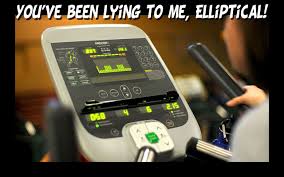How many times have we based the success of our workout on the number displayed under the “calories burned” display on a cardio machine? I know I have before, and I know I’m not alone. I decided to write about this topic because I’ve had many clients ask me about the accuracy of the calorie count on cardio equipment, but when I started to research the topic and think about it more, the blog post took on a life of its own. So, are cardio machines accurate in their calorie count? Short answer: no. My answer: why do you care? First, I will answer the initial question regarding the accuracy of the calorie count on machines, but then I would like you to stick with me as we dive into the implications of allowing that number to determine your actions outside of training.
The main question at hand: “Do cardio machines accurately count how many calories I burn?” No, and here are a few reasons why according to a study (click http://abcnews.go.com/GMA/Weekend/exercise-calorie-counters-work/story?id=9966500 for the study) done in 2010 at the University of California at San Francisco’s Human Performance:
-The calorie count calculations used in most pieces of cardio equipment don’t take your height, body fat percentage, or gender into account
-The calorie counting software in machines don’t account for machine wear and tear. Machine resistance can change over time, meaning what once was a level 8 resistance may now feel like a level 7 resistance. This means that you aren’t working as hard, but you’re erroneously “getting credit” for working at level 8 where you set the machine
-None of the cardio machines calculate a user’s metabolism rate, health history, or fitness level, which would also affect calorie counters
-Human error: if a user is leaning on the machine, they aren’t working as hard and are burning fewer calories. Also, when your body adapts to a certain mode of exercise, you burn less calories to accomplish the same task
Here might be your next inquiry: “Okay, that makes sense. So how far off are the calorie estimations?” Here’s what the same study found:
Treadmill: overestimated calories burnt by 13%
Stationary bike: overestimated calories burnt by 7%
Stair climber: overestimated calories burnt by 12%
Elliptical: overestimated calories burnt by 42%
Yikes! That can be a little worrisome if you’re relying on what the machine is telling you for calories burned. Please note that this isn’t a blanket rule of overestimation as it was just one study and for each individual, calorie burn can vary greatly depending on all of the factors previously listed. The main point here is that the number of calories burnt according to the machine is overestimated and should simply be used as a rough estimate.
Now, let’s get to my answer to the same question. Question: “Do cardio machines accurately count how many calories I burn?” My answer: “Why do you care?” If weight loss is your main goal, you do have to expend more energy than you take in, I am fully aware of that. As a result of this fact, many people choose to count calories and track the number of calories that they expend during workouts in order to see success. There are a few issues that I have with obsessive calorie counting when it comes to exercise (notice that I said obsessive. My word choice is very intentional here- calorie counting can be done in a healthful, productive way. Mindset is everything here!).
In my opinion, there are three things that a workout should never provide, but counting calories often encourages: information about whether or not you had a great workout that day, permission to eat anything, or punishment for something that you already ate.
1. Information about whether or not you had a great workout that day: Someone might feel amazing after their workout only to check their heart rate monitor to see that they “only” burned 250 calories during that intense sweat session. Gone are the feelings of joy and post-workout euphoria, and fully present are feelings of self-judgment and frustration. “I guess I didn’t work as hard as I thought. How could I have only burned that many calories?! Maybe I can go for an extra run later to make up for it.”
2. Permission to eat anything. On the flip side, let’s say you slaved away on the elliptical (aka the worst-offender for overestimating calorie burn) for an hour and go bounding out of the gym, elated because your monitor read that you burned 850 calories! “Success! Now I can have brunch with my friends today and eat 850 calories worth of deliciousness. I earned it”. You can see where this can be extremely problematic if you’re trying to lose weight. Thinking that you burned more calories than you actually did can easily lead to overeating and weight gain.
3. Punishment for something that you already ate. Additionally, how many of us have gone to the gym to “work off” something we ate that day, the night before, the previous week, etc.? I have, and let me tell you, there’s no better way to kill a good workout vibe than to feel like you’re there because you have to pay for a decision that you made in the past.
The cardio machines and their overestimated calorie counts shouldn’t have that kind of power over you. Who’s pushing whose buttons here? You control the cardio machine, remember? Not the other way around. It’s time to stop letting a lit-up display on a machine dictate your emotions and your choices. *Steps off of soap box*
Now that I got that off my chest, I’d like to offer you some ways around calorie counting that can help you see the results that you want and hopefully help you step out of the hamster wheel of obsessive calorie counting.
It’s your turn: Apply what you’ve learned!
-Build a better plate: Your plate should contain about 50% non-starchy vegetables (like leafy greens, broccoli, green beans, etc.), 25% protein, and 25% carbohydrate (choose a whole, real-food carbohydrate source like sweet potato, brown rice, quinoa- look for non-processed items). This, of course, is a just general guideline. Pay attention to how your body responds to this plate construction and adjust accordingly. For example: if you seem to be gaining weight and feeling too full, maybe 1 of your meals needs to include 75% non-starchy vegetables and 25% protein with a healthy fat instead of having the 3rd serving of carbohydrates for the day. See a registered dietician for specific meal plans to suit your needs.
-Stay active by doing exercise that you love. Okay, I know that not everyone loves exercise, but there is something about some styles that you like more than others. Maybe you love going to your personal training sessions because it’s the one time of day that you don’t have to make any decisions, and you just feel so much better afterwards! Maybe you love going on walks because the fresh air lightens your spirit. Or maybe you attend group classes because you’ve made some great friendships there and your workout partners are relying on you just as much as you rely on them. The U.S. Physical Activity Guidelines prompt us to get 150 minutes of moderate-vigorous physical activity per week including 2 strength-training sessions. Try to aim for that amount over the course of your week. It can be broken up into smaller chunks, and every bit of movement counts! One recommendation that has been shown to make a difference in losing weight and keeping it off: for every 30 minutes that you’re seated, get up and move for 3 minutes. Over time, this really adds up!
-MOST IMPORTANTLY: Do these things CONSISTENTLY over time. That’s the secret sauce. If you mess up one meal, no worries, just focus on making the next meal a healthy one and you’ll be right back on track. You will have off-meals, I repeat YOU WILL CERTAINLY GET OFF TRACK AT SOME POINT. Sorry to go all-caps shouty on you, but it needed to be emphasized. The key is to get back on track as quickly as possible for better results.
My final piece of advice: consider your motivation for exercising. Are you working out for you, or are you working out for punishment or permission? Only you get to decide why you work out, and your motivation for doing so matters.
Choose to move because you can.
Choose to move because you want more energy.
Choose to move because you know you’ll feel better afterwards.
Choose to move because afterwards you’ll be more present as a wife/mother/friend.
Choose to move because you enjoy connecting with the other people that you get to workout with.
Choose to move because you’re worth it.


Leave A Comment